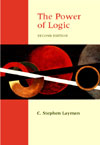|
 |  The Power of Logic, 2/e C. Stephen Layman
Statement Logic: Truth Tables
Learning Objectives
| To gain a deeper understanding of the logical structure of English statements and arguments by translating them into a formal language. |
 |  |  | | To acquire a good working knowledge of the numerous stylistic variants of such key logical words as "not," "or," "and," "if-then," and "if and only if. |
 |  |  | | To become adept at rapidly and accurately translating English statements and arguments into a formal language. |
 |  |  | To know the truth tables for the five logical operators:  <a onClick="window.open('/olcweb/cgi/pluginpop.cgi?it=gif::::/sites/dl/free/0767420330/133352/layman.GIF','popWin', 'width=NaN,height=NaN,resizable,scrollbars');" href="#"><img valign="absmiddle" height="16" width="16" border="0" src="/olcweb/styles/shared/linkicons/image.gif"> (1.0K)</a> <a onClick="window.open('/olcweb/cgi/pluginpop.cgi?it=gif::::/sites/dl/free/0767420330/133352/layman.GIF','popWin', 'width=NaN,height=NaN,resizable,scrollbars');" href="#"><img valign="absmiddle" height="16" width="16" border="0" src="/olcweb/styles/shared/linkicons/image.gif"> (1.0K)</a> |
 |  |  | | To be able to construct truth tables to determine whether arguments are valid. |
 |  |  | | To be able to construct abbreviated truth tables to determine whether arguments are valid. |
 |  |  | | To be able to use truth tables to determine whether statements are tautologies, contradictions, or contingent statements (and to determine whether statements are logically equivalent). |
|
|



 2002 McGraw-Hill Higher Education
2002 McGraw-Hill Higher Education